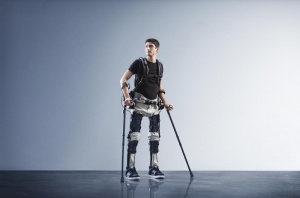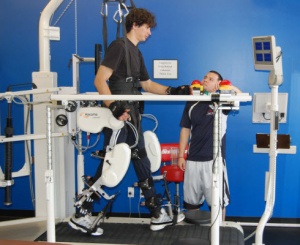Artificial Intelligence (AI) In Health Care and Rehabilitation: Difference between revisions
No edit summary |
(grammar check only) |
||
| Line 23: | Line 23: | ||
== AI Challenges == | == AI Challenges == | ||
In the future as a profession we must learn to embrace these changes and know how to best use AI. Rather than learn more advanced manual therapy skills, or improving our diagnostic skills, | In the future as a profession, we must learn to embrace these changes and know how to best use AI. Rather than learn more advanced manual therapy skills, or improving our diagnostic skills, we may find that to succeed as a profession we need to be able to analysis and interpret AI generated algorithms, apply judgement to them and integrate this AI into our practice eg ethical, professional and social contexts. If we fail to join the conversation around AI and incorporate it in practice, we run the risk that our decision-making will be left to machine intelligence, and not simply informed by it. We must bring humans and AI together to better our outcomes.<ref>Rowe M, Nicholls DA, Shaw J. [https://pubmed.ncbi.nlm.nih.gov/34081573/ How to replace a physiotherapist: artificial intelligence and the redistribution of expertise.] Physiotherapy Theory and Practice. 2022 Nov 18;38(13):2275-83. Available:https://pubmed.ncbi.nlm.nih.gov/34081573/ (accessed 4.1.2024)</ref> | ||
== References == | == References == | ||
Revision as of 07:17, 5 January 2024
Original Editor - Lucinda hampton
Top Contributors - Lucinda hampton, Ines Musabyemariya and Angeliki Chorti
Introduction[edit | edit source]
Artificial Intelligence (AI) can be viewed as the fourth industrial revolution and the emerging frontier in medicine.[1] AI refers to the capability of a machine to perform a functional task overseen insightfully by humans. AI applies algorithms to learn, think, and then ultimately aide various clinical practices such as eg.radiology and rehabilitation. AI also is used to find all relevant current information from journals, books, and evidence-based practice, helping in clinical decision-making in healthcare. Moreover, AI technologies aides in the reduction of medical errors in health care practices.[2]
The emploring of AI technologies is swiftly growing in health care and rehabilitation. As PTs' we need to increase our awareness AI's applications in rehabilitation to provide best practice patient care.[2]
Sport Medicine/Orthopaedics[edit | edit source]
Current studies looking at the use of AI in the areas of orthopaedic surgery and sports medicine show promise in predicting athlete injury risk, the interpretation of medical imaging, evaluating patient-reported outcomes etc. However as with all new knowledge this emerging technology will require a elemental working comprehension of the strengths, limitations, and applications of AI-based tools.[2]
Rehabilitation[edit | edit source]
AI in rehabilitation can augment the patient care by aiding physical therapists in several ways eg providing a thorough assessment, forecasting patients’ performance, establishing a diagnosis. AI in medical and rehabilitation practices can also be applied to problem solving, x-ray diagnosis and protocols for best practice.[2]
Neurology[edit | edit source]
Computer-aided diagnosis (CAD) systems using AI and modern signal processing methods have the ability to help clinicians in analyzing and interpreting physiological signals and images more effectively in Neurological Disorders eg epilepsy, Parkinson's disease, Alzheimer's disease, multiple sclerosis, and ischemic brain stroke.[3]
Brain disorders: The use of AI techniques is helping solve a large number of clinical problems dealing with the brain. Recent research and relevant data accumulation are actively developing an increasingly number of effective algorithms, aiding in our understanding of complex brain mechanism.[4]
AI has vast potential in neurologic physical therapy. AI is being developing that can eg. be used in robotic-assisted therapy; assess motor function and gait, assess clients level of function, upper extremity recovery, and movement. Examples are eg using data from wearable sensors to spot gait patterns (abnormal gait patterns, gait asymmetry etc). AI sensors recognises abnormal movement patterns during functional movements and can be of great value in analysis of functional tasks, and prescription of personalized treatment plans. In concert with telerehabilitation, virtual reality, and body-worn sensors in the future this may be a fantastic way to monitor the type and dosage of home exercises. eg alerts to a remote therapist could be alerted when a patient is performing exercises incorrectly or when there is a need to modify exercises.[5]
AI Challenges[edit | edit source]
In the future as a profession, we must learn to embrace these changes and know how to best use AI. Rather than learn more advanced manual therapy skills, or improving our diagnostic skills, we may find that to succeed as a profession we need to be able to analysis and interpret AI generated algorithms, apply judgement to them and integrate this AI into our practice eg ethical, professional and social contexts. If we fail to join the conversation around AI and incorporate it in practice, we run the risk that our decision-making will be left to machine intelligence, and not simply informed by it. We must bring humans and AI together to better our outcomes.[6]
References[edit | edit source]
- ↑ Ramkumar PN, Luu BC, Haeberle HS, Karnuta JM, Nwachukwu BU, Williams RJ. Sports medicine and artificial intelligence: a primer. The American Journal of Sports Medicine. 2022 Mar;50(4):1166-74.Available:https://pubmed.ncbi.nlm.nih.gov/33900125/ (accessed 4.1.2024)
- ↑ 2.0 2.1 2.2 2.3 Alsobhi M, Khan F, Chevidikunnan MF, Basuodan R, Shawli L, Neamatallah Z. Physical Therapists’ Knowledge and Attitudes Regarding Artificial Intelligence Applications in Health Care and Rehabilitation: Cross-sectional Study. Journal of Medical Internet Research. 2022 Oct 20;24(10):e39565.Available:https://www.ncbi.nlm.nih.gov/pmc/articles/PMC9634519/ (accessed 4.1.2024)
- ↑ Raghavendra U, Acharya UR, Adeli H. Artificial intelligence techniques for automated diagnosis of neurological disorders. European neurology. 2020 Nov 19;82(1-3):41-64.Available: https://pubmed.ncbi.nlm.nih.gov/31743905/(accessed 4.1.2024)
- ↑ Segato A, Marzullo A, Calimeri F, De Momi E. Artificial intelligence for brain diseases: A systematic review. APL bioengineering. 2020 Dec 1;4(4).Available:https://www.ncbi.nlm.nih.gov/pmc/articles/PMC7556883/ (accessed 4.1.2024)
- ↑ Fulk G. Artificial Intelligence and Neurologic Physical Therapy. Journal of Neurologic Physical Therapy. 2023 Jan 1;47(1):1-2.Available:https://doaj.org/article/c7404c4f7fa0437db10c82a4a17524f0 (accessed 4.1.2024)
- ↑ Rowe M, Nicholls DA, Shaw J. How to replace a physiotherapist: artificial intelligence and the redistribution of expertise. Physiotherapy Theory and Practice. 2022 Nov 18;38(13):2275-83. Available:https://pubmed.ncbi.nlm.nih.gov/34081573/ (accessed 4.1.2024)








